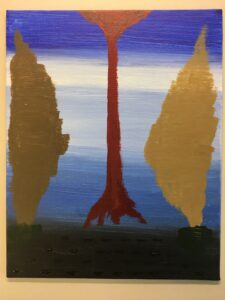 In this abstract expressionist painting, A. K. Evans borrows the “zip” from Barnett Newman’s Onement series in order to call attention to the doubling or duality of characters in both Shakespeare’s The Tempest and Aimée Césaire’s A Tempest. A tree-like line bisects a field of blue (perhaps a clear sky, or perhaps another reference to Newman’s work), while uneven ovals of yellow ochre and raw umber, reminiscent of standing men, face off across the divide. Both colors, however, are supported by the dark stripe at the bottom of the painting, which could be representative of stormy water, or the island, or the uncertain line of the horizon, where an optical illusion appears to erase the distinction between land, sea, and sky. The visual symmetry between the roots and the branches and between “Caliban” and “Ariel” implies a deep connection across difference not only for Caliban and Ariel, but also for colonizer and colonized. These dualities, Evans’s painting implies, coexist with unities of system. Read Evans’s reflection here.
In this abstract expressionist painting, A. K. Evans borrows the “zip” from Barnett Newman’s Onement series in order to call attention to the doubling or duality of characters in both Shakespeare’s The Tempest and Aimée Césaire’s A Tempest. A tree-like line bisects a field of blue (perhaps a clear sky, or perhaps another reference to Newman’s work), while uneven ovals of yellow ochre and raw umber, reminiscent of standing men, face off across the divide. Both colors, however, are supported by the dark stripe at the bottom of the painting, which could be representative of stormy water, or the island, or the uncertain line of the horizon, where an optical illusion appears to erase the distinction between land, sea, and sky. The visual symmetry between the roots and the branches and between “Caliban” and “Ariel” implies a deep connection across difference not only for Caliban and Ariel, but also for colonizer and colonized. These dualities, Evans’s painting implies, coexist with unities of system. Read Evans’s reflection here.



